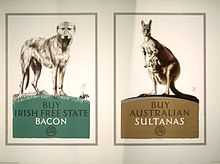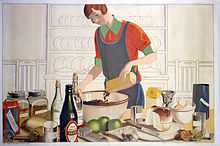Empire Marketing Board


.jpg)
The Empire Marketing Board was formed in May 1926 by the Colonial Secretary Leo Amery to promote intra-Empire trade and to persuade consumers to 'Buy Empire'.[1] It was actually established as a substitute for tariff reform and protectionist legislation and this is why it was eventually abolished in 1933, as a system of imperial preference replaced free trade.
Amery was its first Chairman, Sir Stephen George Tallents its Secretary,[1][2] Edward Mayow Hastings Lloyd its Assistant Secretary,[3] and Walter Elliot was Chairman of its Research Committee.[4]
The EMB had three principal aims:
- to support scientific research;
- promotion of economic analysis; and
- publicity for Empire trade.
Scientific research took up a large proportion of the EMB's work and budget. It also assisted 126 agricultural and medical research projects and issued many Intelligence Notes, pamphlets and surveys. The EMB made links with buyers and produced analyses of markets to help producers. Tallents decided that EMB's staff should employ personnel directly from the media and the advertising industry - as well as giving commissions to some of the most talented poster artists of the day.[1]
The EMB organised poster campaigns, exhibitions, 'Empire Shopping Weeks', Empire shops, lectures, radio talks, schools tour, its own library, advertisements in the national and local press and of shop window displays. Most famous was the EMB film unit led by John Grierson,[5] often considered the father of modern documentary film, which produced around 100 films with such names as Solid Sunshine (which promoted New Zealand butter),[6] Drifters (North Sea herring),[7][8] The Song of Ceylon (tea),[9][10] Wheatfields of the Empire,[11] Industrial Britain[12][13] and One Family.[14][15]
Colonial governments were reluctant to join the EMB, however. The EMB was ended September 1933 as a result of government cuts and the introduction of Imperial Preference.[1] The film unit was moved to GPO, and during World War II was reorganised into the Crown Film Unit.
There is a collection of the EMB's posters at the Manchester Art Gallery and some originals at the Victoria Falls Hotel, Zimbabwe, as well as the National Archives of Canada.[16]
References
- ↑ 1.0 1.1 1.2 1.3 Hack, Karl. "Selling Empire: The Empire Marketing Board". OpenLearn. The Open University. Retrieved 7 June 2013.
- ↑ "Empire Marketing Board". The Times. 21 May 1926. p. 16. Retrieved 7 June 2013.
- ↑ "Mr E. M. H. Lloyd". The Times. 29 January 1968. p. 8. Retrieved 7 June 2013.
- ↑ "Empire Products". The Times. 20 May 1927. p. 11. Retrieved 7 June 2013.
- ↑ Anthony, Scott. "Empire Marketing Board Film Unit (1926-1933)". BFI Screenonline. British Film Institute. Retrieved 7 June 2013.
- ↑ John M. MacKenzie, ed. (1986). "9". Imperialism and Popular Culture. Manchester University Press. p. 209. ISBN 0719018684.
- ↑ Sexton, Jaime. "Drifters (1929)". BFI Screenonline. British Film Institute. Retrieved 7 June 2013.
- ↑ Drifters (1929) at the Internet Movie Database
- ↑ Sexton, Jaime. "Song of Ceylon (1934)". BFI Screenonline. British Film Institute. Retrieved 7 June 2013.
- ↑ The Song Of Ceylon (1934) at the Internet Movie Database
- ↑ John M. MacKenzie, ed. (1986). "9". Imperialism and Popular Culture. Manchester University Press. p. 214. ISBN 0719018684.
- ↑ Anthony, Scott. "Industrial Britain (1931)". BFI Screenonline. British Film Institute. Retrieved 7 June 2013.
- ↑ Industrial Britain (1933) at the Internet Movie Database
- ↑ "One Family". Colonial Film: Moving Images of the British Empire. Arts and Humanities Research Council. Retrieved 7 June 2013.
- ↑ One Family (1930) at the Internet Movie Database
- ↑ "Archives Search". Library and Archives Canada. Government of Canada. Retrieved 7 June 2013.
- 'Buy and Build: The Advertising Posters of the Empire Marketing Board', Stephen Constantine, PRO, London.